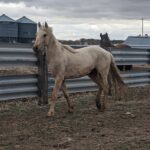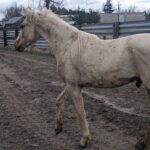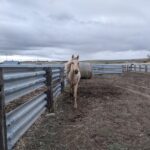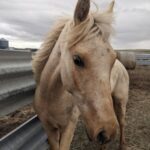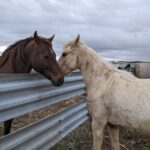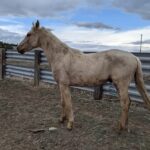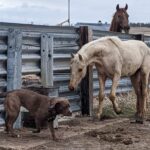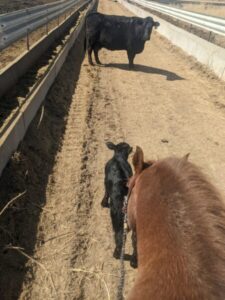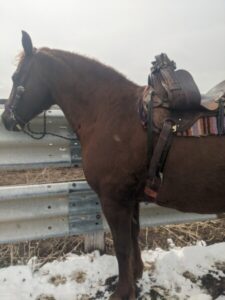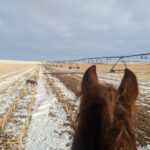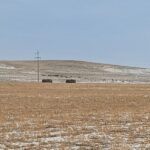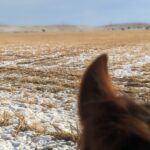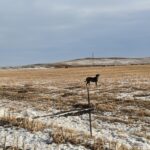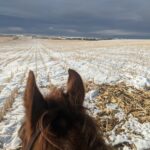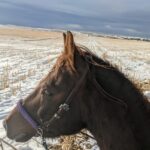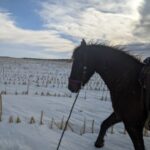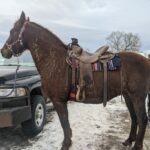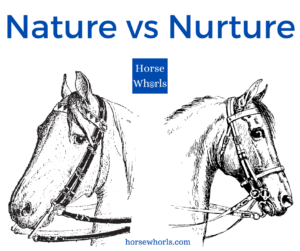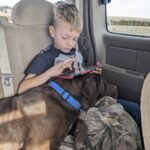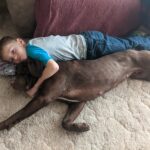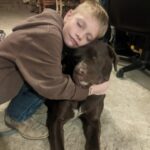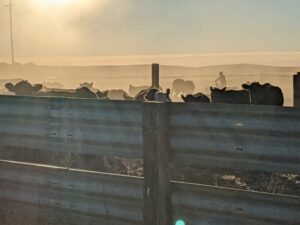The Pitfalls Of Planning
“If we spend too much time in the planning phase we wire neurons in our brain that then cause us trouble when the unexpected happens”. ~Wally Olsen
It is a good thing to sit down and think about what your goals are and how you ‘think’ you’re going to get there. Getting a loose outline down is great. To carefully lay out exactly how and what you plan to do is where you get into trouble.
We can have all the ideas of how you think things are going to go that you want. Your horses don’t know what you have planned. They’re going to do their own thing. Regardless of how you decided the training session was going to go.
If you have already set down and built major neural highways following this one specific training plan your brain is going to have a harder time switching courses and choosing a new path to follow.
Think about what you think is going to happen, make a plan for more than one possible outcome, then be prepared to let all of that go and follow an entirely different path. With horses nothing ever goes as expected, often the new roads they lead us down are far better than what we were able to come up with on our own.
The neural highways most traveled are the ones your brain will work hardest to keep building bigger. Make sure those pathways are good ones.
Nothing New
We are never teaching a horse to do anything they don’t already know how to do.
We may be teaching them to do it when asked. Or showing them how to do it using their body more effectively. But the horse can move, on their own, far better than they can with us sitting on their backs.
I was listening to a podcast the other day as two very skilled horsemen talked about how the best thing they ever learned was to get out of the horse’s way. Deep down I know this. In reality, I always have contact on the reins. I like to think I’m not hanging on their mouths, just helping. There are many things we all like to think in life, that doesn’t make them true.
I’m riding quite a bit at the moment. Checking cows, sorting pairs, nice training type horseback work. Things where I can take it slow, set my horse up right, then let go and allow him to do it on his own. A perfect opportunity to put “staying out of their way and letting them do the job” to work. Added to this I can click and reward Rusty when he does an exceptionally good job. These are quickly working together to develop him into a cow horse who will not only do as asked but who understands the goal and will work towards it on his own.
When we have to get up the narrow lane past cows and calves to get them turned back the other way, he turns his head to the outside, carefully not making eye contact. When we have to do this at more speed he isn’t dropping his hindquarters and spinning after the cow, not yet. But I’m also asking him not to. It’s still icy and slick out there. When we’re bringing one cow along through the bigger corrals, he is starting to hold a line and work her when she turns back at us. He will trail her to the gate almost completely on his own, just a few small adjustments from me when really needed.
He gets a click and reward every time a cow goes through a gate. last year that resulted in him taking one through on his own after I had stepped off.
There’s a difference between a horse who can understand and work towards a goal and one who will respond to cues. I’m not saying he is a super cow horse. He doesn’t get ridden enough to hardly make him competent. He is a trustworthy partner who will put his mind to getting the job done. That is worth way more to me than a horse who will respond better than him to cues but whose mind isn’t engaged.
Tightening The Cinch
I usually ride with a pretty loose cinch. It gets me in trouble sometimes.
I’ve accidentally roped things. That I would ever actually catch something came as a shock to me. Figuring out what to do with the rope then became an even bigger shock.
Rusty’s occasional small explosions keep that loose cinch interesting too. He’s a very well behaved horse, with a ton of buried energy. Sometimes it stays well hidden and I think I have a slow lazy horse. Other times he is bursting at the seams with vibrating energy that can barely be contained, small things that never usually bother him become terrifying. On those days it’s best to get off and tighten my cinch.
He isn’t bad. I would never call Rusty’s behavior bad. That doesn’t mean it doesn’t make riding a little more challenging. When we need to take on those greater challenges with our horses, the place to start to help them find a calmer place is by being able to be calm ourselves. When I’m having to grab mane and worry about my balance and the saddle staying put, I’m not at my calm best.
That need, for our calm best, doesn’t change no matter what our horses are worried about. We can’t help our horses not to be upset if we are upset. With Rusty when he needs help calming down I step off and tighten my cinch. That helps me find security and shrug off worry.
The steps we take to find a safe comfortable place to work from will change depending on what our horses are worried about. Sometimes we let ourselves be put in a place that isn’t safe for us to deal with our horses out of habit. It can be hard to remember to tighten that cinch if we aren’t used to doing it. We forget that ‘normal’ doesn’t have to stay normal for us. Sometimes because of the expectations of others. Toughen up, get out there and show that horse whose boss. If you get off now the horse will have won! Who hasn’t heard those before.
Getting off can be embarrassing, but it is never a bad idea. It isn’t true that the horse has won or that you will have taught them to misbehave. Keeping yourself safe is an important thing to do when a horse is scared!
What do you do when your horse is afraid? Do you have a method you use to calm yourself when your horse gets worried?
Checking Fence
The cows have been locked in the corral for a few weeks now. It isn’t so much that we want them in as that we can’t get them out. The lanes and gates are full with drifts. The fields covered in snow.
I’m ready to get those calves weaned and get the cows out of the corrals!
There’s no way a 4wheeler or pickup is going to get through the drifts to check the fences in the fields. A horse can though. So I saddled Rusty. This wasn’t a bareback sort of a job. Getting on and off to work on the fence and lunging through snow drifts is easier with a little help. I thought as I left Rusty tied to the pickup and climbed through snow drifts to get my saddle. I was a little overly optimistic.
The end of the drive is still drifted shut. Rusty objected to having to walk through drifts. I urged him on. Once we got to the other side I thought maybe I had worried too much. The corn stalks had caught quite a bit of snow. Each row of stalks was clear down to the ground with eight inches or so in between. The alfalfa was blown mostly clear. It’s so fun to see the effects debre left in fields has. We know it catches snow, how much snow is great to see. I had to listen to people talk all through Christmas about how this snow didn’t do any good. None of it was left on the fields, out in the open. Only places with drifts will get watered by it. I guess it’s easy to say that from a seat inside house or car. Getting out and riding through it gave a wonderful idea of how much this snow helped. Where there was something to catch and hold it.
A herd of fifty plus deer scattered in front of us, before we got close enough to see them good. One must have been sleeping. He popped up right next to us. Pansy briefly gave chase, but thought better of it as the deer quickly outdistanced her.
Rusty was full of himself. Stopping to stare in terror at the deer. Or refusing to hold still so I could get a picture. We pranced and snorted. I let him trot through the deep flat snow for awhile in hopes of using up some of that energy. Between treat bag and pliers it was an interested go. They all bounced around getting into the way. I held onto pliers and reins and tried to keep everything under control. Circling and pawing when I held him back Rusty was having fits. He was ready to go home.
Turning back in the direction of home down the last fence line I was so busy trying to hold it all together that I didn’t realize until we were in the thick of it how bad the snow was getting. Up on top of the hill where the wind should have blown the worst, the drifts were the deepest. it’s amazing how much snow a single barbwire fence will catch. We have a neighbor who pulled out all his old fences, just because he isn’t running livestock on his crop ground. His fields are blown down to dirt where the fences used to be. Instead of covered with good moisture bringing snow like the fields around them.
Rusty was beginning to struggle through the snow. It went quickly from a few deep drifts to deep snow with a few huge drifts. He lunged up onto the top of a drift, it held his weight. I held his mane. We stayed together. Then his front feet broke through. His front end sank out from under me. I went quickly from trying not to get left behind to trying not to get pitched over his head. Fencepliers clanked and treat bag got in te way as I struggled to stay with him and out of his way. He fought his way through the drift to the relatively shallow snow on the other side. I made him stop and take a breather.
Looking around I tried to judge where snow might be shallow. It hadn’t seemed so bad just a brief moment ago. Surely we could get back out of this mess. All around the snow looked the same. Corn stalks peeked out the top of the snow. Or in some places didn’t. Our only option was to keep going. Head for the places that looked slightly more shallow.
I got off to walk.
Together we climbed. Sometimes staying on top for a few steps, then sinking to the ground. Rusty was in a hurry. I was holding him back. If I kept him close it was just asking to get stepped on. If I let him go to the end of the rein he was walking circles around me. If I let him go he’d go right through the fence at the end of the field.
If he could run circles around me he could carry me.
I got back on for the last stretch. He charges ahead. Without any more big drifts we didn’t have any more close calls. Through the wire gate and we were out. It had only been a little under a half mile but it felt like we had run an endurance race. Rusty was lathered. I was panting. The ground was bare beneath us as we left the gate.
There was a big drift up ahead. I was watching it wondering where the best crossing would be when Rusty gave one of those big teeth jolting shakes. As he zipped on I noticed my reins weren’t hanging right. They went straight down. To my bridle he had shaken off his head!
Rushing home, with a very big drift just in front of us, and he had shaken off the bridle.
I pulled back on the reins, knowing it would pull on his neck. We ride with a neck rope sometimes. He knows what it means, if he chooses to acknowledge it. He paused, I gave him a cookie. He accepted it, then was off again before I could be off. I lifted the reins so I had leverage nearer the throatlatch and pulled back again. This time I hopped right off before giving him his cookie for listening.
Already off I stayed off for this drift. It stretched across the road and was as high as his belly at the lowest spot. He lead me again, pulling me along at the end of the rein. It held his weight, except when it didn’t He lunged and sped and we were through it in no time. Now we could take a plowed path the rest of the way home.
He and I were both ready to be done. He was walking his fast Morgan walk and had us there in no time.
Yes, he was able to get through where nothing else could have. Did it mean we should have? Probably not. Had I realized what we were getting into we would have gone around, or turned around and gone back the easy way. Already stuck in a bad spot, he did an amazing job of getting us home safely. He was careful not to step on my legs when they were hidden under all the snow. For all his hot impatience he was still very good. We got the fence checked. A job well done.
Other than a couple of places along the yard it was good. All those deep drifts we struggled through hadn’t covered the wires at all.
Nature vs Nurture
It’s For The Dogs
Lately I’ve been spending a lot of time with a dog.
Our last dog was practically perfect. She came when called, didn’t cause trouble, and was always there with us, happy to hang around. She was also somewhat neurotic, especially when it came to food. It worried her greatly if there were people involved when she was eating and she was very picky about what she would eat.
So we didn’t do much training.
This new dog is a huge puppy. She’s friendly and enthusiastic. Her nose is right at table height and her mouth is large, wet, and she likes to greet people with it. She’ll happily eat anything that gets close enough to reach with no shyness or worry.
She needs lots of training!
I know and love horse training. The basics of training dogs and horses are the same. I hear the gasps and denial already from more traditional trainers. No, I’m not going to round pen a dog. But when training with food all species learn the same, and even plants which opens up new and interesting thoughts and ideas of what is ‘alive’ and what isn’t but I digress.
While the basics are the same the devil is in the details. It’s been fun these last couple of weeks figuring out some of those details.
Some are very simple.
We don’t want her bagging at the table. So we ignore her. Letting our elbows absorb the wetness of that ever exploring mouth, protecting food and plates by blocking her access. Then when she gives up and lays down at the door I rush to reward her. The whole family gets in on it, pointing out that she should be getting a treat if I’m late or running to feed her themselves. It’s fun and no punishment is involved. Already, within the first couple of days, she will make a lap around the table then go lay down to wait.
So much faster and more effective than some of the methods I’ve seen, like squirting them in the face with a spray bottle. The funniest was when one person was feeding from the table, while the other squirted feeder and dog with the spray bottle. Obviously nothing was learned there.
A more difficult and subtle learning is teaching her to please only walk on my right side.
I have a bad knee. It tends to dislocate. A really fun thing where I get to reach down and push the knee cap back into place, which is as sickening a thought as an actual undertaking. This new dog has bumped into that knee and knocked it out. It wasn’t on purpose, obviously. and she wasn’t doing anything bad. She’s just big and playful.
In order to avoid more of this we’re working on keeping her to the other side.
She isn’t on a leash so there is no holding her on that side. Instead I carry something in my left hand. Not to hit her with but if something is swinging around there blocking her way we’re setting it up to be easier to come up to me on the other side. I also try to avoid petting her when she’s on the left side. Small things to start to form a habit.
This is a learning process, and a fun one. I can’t wait to see what we can accomplish together. Hopefully she will learn some tricks. But that foundation is the important thing as we’ll get that down so she can be a good member of society, the most important thing in horses too. Then we’ll add that extra frosting of tricks.
Women’s Work
When working cattle everyone has a job to do.
These jobs are assigned based on everyone’s skills and where they can best be used. Granted it doesn’t always work out that way. In which case others may need to jump in and get the job done.
We will just assume that in general, everyone is going to quietly go about doing their job.
In order for the work to go smoothly, everyone needs to do THEIR job. When a job is ignored to watch someone else do their work, then there’s a job out there not getting done. That can create a big hitch in the get along.
Allowing people to do their job while taking care of your own still applies if one of the people working is female. Being female does not magically mean that she will need a man to come along and ‘help’ do her job. Being female does not mean she will be weak, incapable, or incompetent. In fact there’s a good chance that being female will mean that she is skilled, hard working, quiet and easy going in her way of working cattle.
Odds are the men who are convinced that the poor little woman needs his help will not be.
If he were skilled and capable, he’d see work being well done and leave well enough alone.
By all means keep an eye on your fellow workers next time cattle are being handled. If a job isn’t getting done, pitch in. If you think a job may not be able to be accomplished because of the sex of a hand, maybe check in your britches to make sure you aren’t compensating for an undersized pee pee.
Back To Work
Thresholds
Threshold, in this case, refers to the level at which the horse becomes afraid.
Keeping a horse well below threshold means they are never worried about anything.
Getting a horse way over threshold removes any ability to learn. They wont take any offered food to help calm them down. They are too afraid to eat. So feeding for calmness wont help. A horse who is scared can’t think, they wont remember anything you try to work on while they are in this state. Other than that what you did with them made them afraid. Keeping a horse well over threshold without any way to escape the fear brings on a state of learned helplessness.
Learned helplessness is when a horse has given up. They can’t escape the fear so they shut down. They seem fearless because of their lack of reaction.
With most of the training we do, we want to stay well below threshold. Our horses will be happy and gobble up all that we can teach them. By working in this area we will build a solid foundation of trust so when we cross that threshold they will be better able to rely on us and know we will get them out safely. All training to help them over come fear has to come before the fear is present.
By pressing close to threshold without crossing over, we can sample fear in small doses and show the horse that we will keep them safe. Offer a taste of fear, then back away, give treats, offer support and comfort so we become the safe place when there is danger. Not physically the safe place of course 😉
Once we have crossed threshold it is too late to do any training. All we can do is our best to get them back to a safe place, mentally and physically, so we can recover and meet the challenge better prepared next time!
